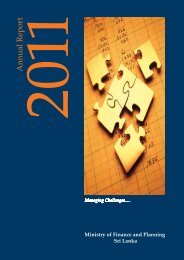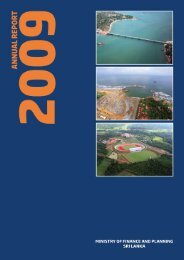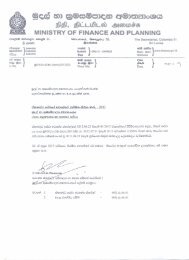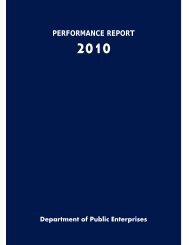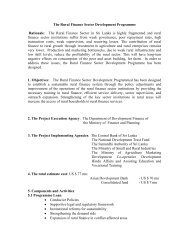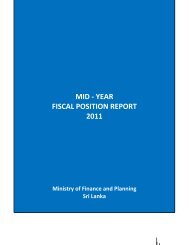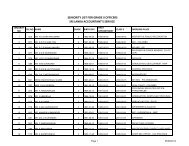Annual Report 2010 - Ministry of Finance and Planning
Annual Report 2010 - Ministry of Finance and Planning
Annual Report 2010 - Ministry of Finance and Planning
You also want an ePaper? Increase the reach of your titles
YUMPU automatically turns print PDFs into web optimized ePapers that Google loves.
<strong>Ministry</strong> <strong>of</strong> <strong>Finance</strong> <strong>and</strong> <strong>Planning</strong> Sri Lanka > <strong>Annual</strong> <strong>Report</strong> <strong>2010</strong>Reconciliation <strong>and</strong> DevelopmentThe Government has placedhighest priority on accelerating thedevelopment <strong>of</strong> the conflict affectedareas <strong>and</strong> improving living conditions<strong>of</strong> the people therein, which hassignificant bearing on the nationalreconciliation process. In line withthis policy, a broad set <strong>of</strong> policies <strong>and</strong>measures have been implemented bythe Government, complemented bythe support <strong>of</strong> development partners,including Japan, China, India, Germany,Switzerl<strong>and</strong>, Australia, World Bank,Asian Development Bank (ADB),United Nations (UN) agencies, suchas United Nations DevelopmentProgramme (UNDP), United NationsChildren’s Fund (UNICEF), World FoodProgramme (WFP), the EuropeanUnion (EU) <strong>and</strong> the International Fundfor Agriculture Development (IFAD)as well as other stakeholders, to bringthe affected areas back to normalcy.Resettlement <strong>of</strong> IDPs <strong>and</strong> fast trackdevelopment <strong>of</strong> the Northern provincewhile creating a safe environment forthe people to return to their places <strong>of</strong>origin was the approach taken by theGovernment in this process. With theseinitiatives, the Government has ensuredthat the areas affected by the terroristinsurgency are provided with thedevelopment support needed for themto leapfrog into the future.Two multi-pronged regionaldevelopment strategies, i.e. “UthuruWasanthaya” <strong>and</strong> “NegenahiraNavodaya”, have been implemented asthe major programmes in addressingimmediate requirements as well aslong st<strong>and</strong>ing development needs <strong>of</strong>the Northern <strong>and</strong> Eastern provinces.The identification <strong>of</strong> priorities <strong>and</strong>preparation <strong>of</strong> plans accordingly,accelerated implementation <strong>of</strong>“180-Day programme”, effectiveimplementation, continuousmonitoring, setting up <strong>of</strong> necessaryinstitutions <strong>and</strong> ensuring theircapacity building were among thesalient features <strong>of</strong> the initiatives <strong>of</strong>the Government, particularly in theNorthern province.In a broader sense, the programmesimplemented in the Northernprovince, after the successful ending<strong>of</strong> the insurgency in May 2009, areaimed at ensuring the welfare <strong>of</strong>internally displaced persons (IDPs),demining activities, resettlement <strong>and</strong>rehabilitation, <strong>and</strong> reconstruction<strong>and</strong> development <strong>of</strong> the affectedareas. Total cost <strong>of</strong> the developmentactivities carried out by theGovernment in <strong>2010</strong> in the North& East amounted to Rs. 45 billionwhich is about 1 percent <strong>of</strong> GDP.Table 1.2 > Resources Channelled to NorthernProvince Development Activities in <strong>2010</strong>ItemAmount (Rs. Mn)Welfare <strong>of</strong> IDPs 5,459Demining 3,696Resettlement 1,900Infrastrucure Development 26,570Total 37,625Source: Department <strong>of</strong> National Budget, National Mine Action CentreAlso, the total commitment madeby development partners by end<strong>2010</strong> to implement various projectswas about USD 2.1 billion. With thegradual progress <strong>of</strong> the initiatives,the Government has been able tobring the area back into normalcy,which however needs further actionsto consolidate these achievements<strong>and</strong> ensure long term sustainabledevelopment in the Northern provinceas early as possible.Internally Displaced People<strong>and</strong> their WelfareAt the time <strong>of</strong> ending the terroristinsurgency in May 2009, there were295,136 IDPs who could not go back totheir own places. The majority <strong>of</strong> themwere from Mullaitivu <strong>and</strong> Killinochchidistricts, which have been highlycontaminated by l<strong>and</strong> mines <strong>and</strong> otherunexploded ordinances (UXOs). Theywere initially accommodated in welfarecenters <strong>and</strong> subsequently brought into welfare villages.The highest priority was given bythe Government for the welfare <strong>of</strong>these IDPs <strong>and</strong> the welfare villageswere managed by following bestpractices across the world in runningsuch activities. Accordingly, the IDPswere provided with all basic facilities,including food, water, health, <strong>and</strong>shelters. More importantly, the IDPswere given 1,900 Kilo Calorie daily,which is equivalent to st<strong>and</strong>ards <strong>of</strong>the WFP. In addition, such facilitiesas primary healthcare centers, mobilehealth clinics, night clinics, mobilelabs, operation theaters, counselingservices, were also provided to welfarevillages. Furthermore, other mainfacilities, such as schools, religioussupport, banks, shops, communicationfacilities etc. are also provided. Thesecurity for the IDPs was provided bythe security forces <strong>and</strong> police while theday to day work is h<strong>and</strong>led by civilianadministration.35



